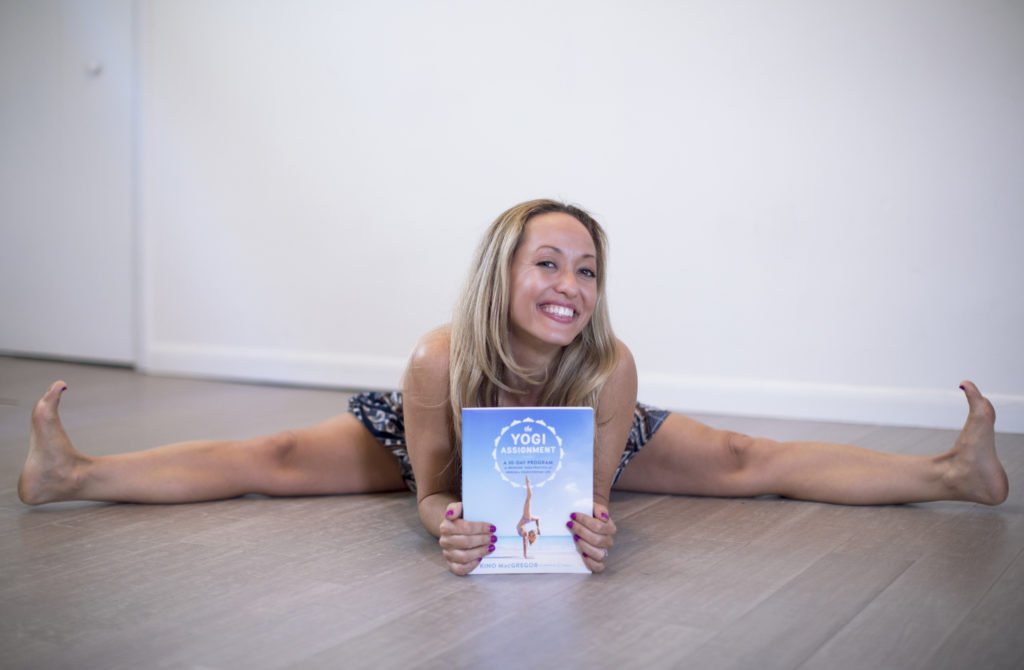As we traverse the winding path of life in today’s fast-paced world, we inevitably come up against many trials and tribulations. In her new book, The Yogi Assignment, released in late September, Kino MacGregor reminds us that while challenging life events are unavoidable, suffering is a choice. This concept reflects an essential component of yoga—the spirituality of the practice—that is being gradually lost in the West as these methods become increasingly secularized.
Known for her radiant presence and highly accomplished āsana practice, Kino is a seasoned Ashtangi based in Miami where she has been running a traditional shala, Miami Life Center, with her husband, Tim Feldmann, since 2006. Kino and Tim are among the few people to receive the Aṣṭāṅga Yogi Certification from its founder Sri K. Pattabhi Jois, or Guruji. She is also the co-founder of OmStars, a new online yoga channel featuring online videos and tutorials created for yogis by yogis. Kino knows the value of being a student, too, making an annual pilgrimage to Mysore, India to practice under her Paramaguru Sharath Jois.
In her latest book, Kino frames her yoga practice in terms of the spiritual growth she has experienced over the last 20 years. Right off the bat, Kino opens up about her lifelong struggles with depression (since age nine), panic attacks, and self-doubt. With courage and candor, she also notes her experience as a victim of sexual abuse and how hard it was to “tell no one and pretend that everything was normal.” She admits this early trauma led her to substance use, narcissism, and fear. Like many, she turned to yoga to heal.
“Tears are no surprise in yoga class,” Kino writes. “It is not our perfections that connect us, but our vulnerability. It is the tenderness of our broken, cracked hearts that makes us who we are…You are exactly where you need to be, going through exactly what you need to be going through.”
“When there are tears, yoga is working.” — R. Sharath Jois
When she first began to practice, Kino interpreted Guruji’s advice to “be stronger” as muscular strength. But over time, while studying under Guruji and his grandson, Sharath Jois, she realized the practice required as much mental as physical toughness. “Practice, practice, and all is coming,” Guruji would say to Kino, challenging her to dig deeper.
Recent science, Kino points out, supports her claims of yoga’s incredible abilities to alleviate symptoms of anxiety and depression. Through her practice, she has gone from emotional unmanageability to a place of personal strength and self-regulation. She specifically discusses how various poses can tap into this sense of vulnerability and the healing process. This metaphorical translation of certain poses throughout this book is rich and satisfying for the reader. One poignant example of this elaboration on complex spiritual themes is her insights on anuvittasana (standing backbend), offered early in the daily āsana assignments.
“Observe your emotions. Hanging over in a backbend often brings up fear, panic, anger, sadness, and a host of other emotions. Remain equanimous and re-pattern your neurological response to these difficult emotions. Bring your emotions up to the surface and accept them with the power of the breath, the pose, and the focal point,” she writes.
Through 30 days of daily assignments, like this one, Kino takes readers on a practice of self-exploration and empowerment. The foundation for these assignments is the 2,000-year-old “bible of yoga,” Patanjali’s Yoga Sutras. The sutras don’t discuss āsana, but instead focus on the spiritual awareness that comes through practice; the awakening that stems from the eightfold path of yoga. This inner journey is the theme of Kino’s book, and she sees the guidance of the sutras as the key to yoga.
Kino grounds each daily exercise through the lens of the eight limbs of yoga. Beginning with day one—nirodah or stillness—she ensures that each āsana is seated in a sense of calm and mindfulness. Throughout the assignments, Kino advises yoga practitioners to let go of expectations, hone in your personal awareness, and apply the metaphorical teachings of a full yoga practice to daily life. This means nurturing the body gently, not forcing yourself into poses that you’re not ready to attempt.
Related: The Eight Limbs of Yoga Explained
While some of the postures in this book are more advance, such as mayurasana and koundinyasana, Kino notes repeatedly that we are not meant to visually mimic the pose identically, but only to begin moving toward these “ideal” shapes. She consistently reminds readers to be gentle and never to force a posture. Kino herself admits to falling, failing, and trying again to reach certain āsanas for decades. It’s not about the goal, but the journey, and that message is reiterated throughout the assignments. This is an inner exploration that can lead to a deeper sense of self-love, faith, and presence.
In her final chapters, Kino shares her wisdom on how to maintain an ongoing practice. “We all need a feeling of belonging and a sense of lasting peace,” she writes. When we devote ourselves with love to not only our practice, but to each moment, we cultivate a space of divinity in our lives. Kino reminds us that sense of “home” is always within, we simply need to seek it. “With faith, follow the subtle glow that is the seed of your new dawn. Seek your home in the world within, and it will be revealed,” she writes.
As we establish an oasis of self-compassion and peace, our daily lives are infused with greater meaning and joy. It is this message that resonates with so many today during a time when we need this inner strength perhaps more than ever.
Photography courtesy of @kinoyoga.









Comments (0)